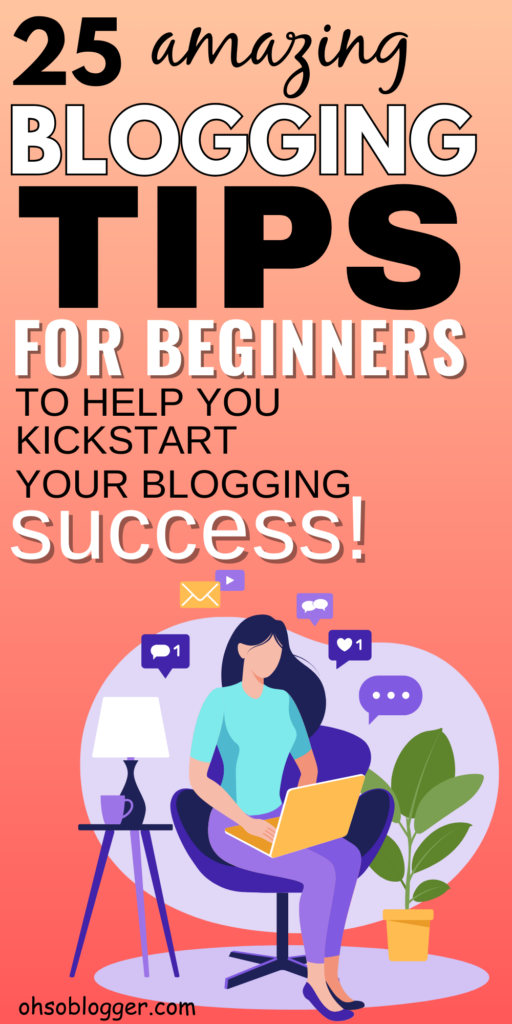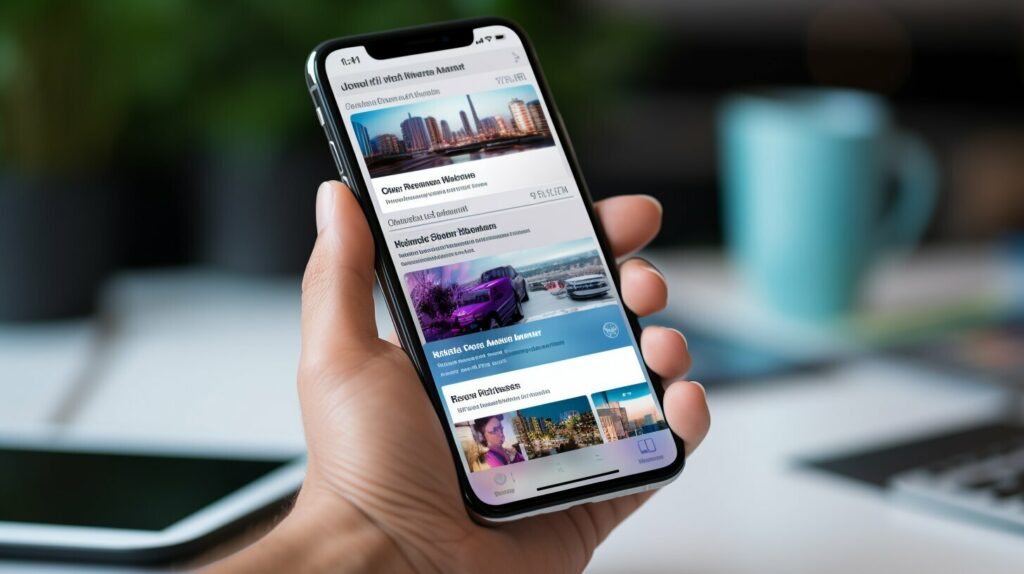25 Blogging Tips for Beginners to Help you Kickstart your Success
Starting a blog can be an exciting and rewarding experience. However, as a beginner, it can be overwhelming to figure out where to start and how to navigate the process.

That’s why in this article, I’m sharing 25 valuable blogging tips for beginners that will serve as a foundation for your blogging journey.
From choosing the right niche to crafting engaging headlines, I’ll cover some awesome tips and tricks to help you create a successful blog that resonates with your target audience.

So, whether you’re a hobby blogger or looking to turn your blog into a business, these tips will provide you with a solid foundation to kickstart your blogging journey and help you find success.
25 Useful blogging tips for beginners
Choose Your Niche Wisely
Choosing the right niche is the foundation of a successful blog. Your niche should align with your interests, expertise, and target audience. Here are some tips on how to choose your niche wisely:
- Identify your passions: Your niche should be something you enjoy and are knowledgeable about. Consider your hobbies, personal experiences, and areas of expertise.
- Research the market: Look for a niche with high demand and low competition. Google Trends and keyword research tools like Ahrefs and SEMrush can help you identify popular topics.
- Consider your target audience: Your niche should appeal to a specific audience. Understand their needs, pain points, and interests to tailor your content to them.
- Evaluate monetization potential: While not necessary, it’s important to consider if your niche has potential for monetization through affiliate marketing, sponsored content, or product sales.
Remember, your niche should be something you enjoy and are passionate about. Don’t choose a niche solely based on its potential for profit. You’ll be more successful if you create content you love and are knowledgeable about.

Start Your Blog as Cheaply as Possible
When starting your blog, it is prudent to start as cheaply as possible. This will make it so much easier to keep up with your new blog in the first few months when growth is very minimal.
This is especially important if you’re on a tight budget. Most blog do not make any money (or just a few pennies) in the first month or two. If you do most things right, then you can expect to make a few hundreds or even $1000 per month between month 7 – 12.
Therefore, if you budget is tight, you need to be able to keep your blog online for the first 12 months without factoring in income that comes directly from the blog incase it takes longer to earn money form it.
Many new bloggers make the mistake of paying too much to start their blogs and can’t keep up with he expense. Ultimately, they have to give up on their blog before it even starts to make money because it’s too expensive to keep.
This is why I recommend starting with Siteground. It costs less than $70 to start your blog with Siteground and you won’t have to pay for any hosting again until the first 12 months are up!
This is how I start most of my new blogs. You can see how to start a blog with siteground here if you’re interested.
Set Clear Goals for Your Blog
As a new blogger, it’s important to set clear goals for your blog to help you stay focused. Without goals, it’s easy to get sidetracked and lose motivation. Setting achievable goals will help you measure your progress and keep you on track. Here are some tips to help you set clear goals for your blog:
Define Your Objectives
Start by defining your objectives. What do you want to achieve with your blog? Do you want to establish yourself as an expert in your niche? Or do you want to generate income through your blog? Once you define your objectives, you can identify the metrics you need to track to measure your progress.
Set Realistic and Achievable Goals
When setting goals, it’s important to be realistic. Consider your current level of experience and the time you can realistically dedicate to your blog. Setting achievable goals will prevent frustration and keep you motivated. For example, if you’re just starting, aim to publish one to two high-quality blog post per week.
Track Your Progress
Tracking your progress is essential to measure the success of your blog. Use tools like Google Analytics to keep track of your metrics, such as traffic, bounce rate, and engagement. Regularly review your progress and adjust your goals accordingly.
Understand Your Target Audience
One of the most critical aspects of creating a successful blog is understanding your target audience. By knowing who your readers are, you can tailor your content to their needs and interests, which will ultimately drive engagement and build a loyal following.
So, how do you go about understanding your audience? Here are some tips:
Conduct Research
One of the best ways to understand your audience is to conduct research. Use tools like Google Analytics to gather data on your readers, such as their demographics, interests, and behavior patterns. You can also conduct surveys or polls to gain more insight into what your audience wants to see from your blog.
Create Buyer Personas
Another effective way to understand your audience is to create buyer personas. A buyer persona is a fictional representation of your ideal reader, based on research and data. By creating detailed buyer personas, you can better understand your audience’s needs, pain points, and motivations.
Engage with Your Audience
Engagement is key to building a loyal following. Respond to comments and messages from your readers, and encourage them to share their thoughts and opinions on your blog. By fostering a sense of community, you can gain valuable insights into your audience’s needs and preferences.
By taking the time to understand your target audience, you can create content that resonates with them and drives engagement on your blog.
Consistent Posting Schedule

One of the most important factors for a successful blog is consistency. Posting regularly keeps your readers engaged and helps build a loyal audience.
Many people recommend posting less frequently and making quality the main focus. This is sound advice.
However, if you do not mind using A.I tools, you can easily speed up your writing. If you do use A.I to publish more content, ensure that you EDIT and fact check, but it is sure to boost your publishing schedule.
Again, quality should always come first, don’t skip the editing and fact checking so you provide valuable information to your readers.
Here are some tips to help you establish a posting schedule:
1. Determine Your Ideal Posting Frequency
Consider your niche and the amount of time you have to dedicate to your blog. Decide how often you can realistically post without sacrificing quality. Some bloggers post daily, while others post weekly or biweekly. It’s up to you to determine what works best for your blog.
2. Create a Content Calendar
A content calendar is a great way to plan your blog posts in advance. This allows you to have a clear idea of what you’ll be posting and when. You can use a simple spreadsheet or specialized tools like Trello or Asana to create your content calendar.
3. Be Prepared to Adjust Your Schedule
Life happens, and sometimes you may be unable to stick to your planned schedule. It’s important to be flexible and adjust your schedule if necessary. Your readers will understand if you need to take a break or post less frequently for a while.
Conduct Keyword Research
Keyword research is a critical component of any successful blog. It involves identifying and analyzing the search terms and phrases that your target audience uses to find the content they need.
By conducting keyword research, you can optimize your blog to rank higher on search engine results pages (SERPs) and attract more organic traffic to your site. Keyword research is also relevant for Pinterest optimization. Here are some essential tips on how to conduct keyword research effectively:
Start with Seed Keywords
Seed keywords are general terms related to your blog’s niche. Begin your research by brainstorming relevant seed keywords that you think your target audience would search for.
Use Keyword Research Tools
Keyword research tools such as Google Keyword Planner, Ahrefs, and SEMrush can help you find relevant keywords and analyze their search volume, competition, and potential traffic. An example of a seed keyword is cappuccino.
Analyze Long-Tail Keywords
Long-tail keywords are more specific search terms that contain three or more words. They have less competition and a higher conversion rate as they are more likely to be used by users who are ready to take action. Analyze long-tail keywords related to your seed keywords to identify low-hanging fruit opportunities for your blog. An example of a one tail keyword is How to make cappuccino muffins.
Keep an Eye on Your Competitors
Analyze your competitor’s blogs to see which keywords they are ranking for, and consider incorporating those terms strategically into your blog content to increase your chances of ranking higher.
By conducting thorough keyword research and incorporating relevant keywords into your blog content, you can increase your visibility on search engines and attract more traffic to your blog.
Similarly keyword research on interest can help you rank high in the Pinterest searches. If you’re starting a new blog, you should decently look into Pinterest to promote your blog for free.
Craft Engaging Headlines
Your blog post’s headline is the key to grabbing a reader’s attention and piquing their interest. You want to make sure your headline is both attention-grabbing and accurately reflects the content of your post.
When crafting your headline, keep in mind your target audience and the keywords you want to rank for. Use action words, numbers, and sensory details to make your headline more engaging.
It’s also essential to keep your headline concise and to the point. A lengthy headline can be overwhelming and turn readers away.
Tips for Creating Catchy Headlines
1. Include Numbers: Adding numbers to your headline makes it stand out and provides readers with a clear understanding of what to expect from your post. For example, “10 Tips for Creating Eye-Catching Social Media Graphics”
2. Use Emotional Triggers: Words like “amazing,” “surprising,” and “unbelievable” evoke emotions that grab the reader’s attention and make them curious about your content. For example, “Amazing Hacks to Simplify Your Morning Routine”
3. Ask a Question: Asking a question in your headline engages the reader and encourages them to read on for the answer. For example, “Is Your Blog Content Driving Traffic to Your Site?”
By following these simple tips, you can craft attention-grabbing headlines that entice readers to click and read your blog content.
Optimize Your Blog for Mobile Users
If you want to attract and retain mobile users, your blog must be optimized for mobile devices. A mobile-friendly blog provides a seamless user experience across all devices and screen sizes. This is especially important since the majority of internet users access content on their mobile devices. Here are some mobile optimization tips for beginners:
Responsive Design

A responsive design allows your blog to adapt to different screen sizes and devices. This means that your layout and content will adjust automatically to ensure a smooth user experience. A responsive design can help increase your blog’s rankings on search engines, as search engines prioritize mobile-friendly websites.
Optimize Page Speed
Mobile users are often on-the-go and expect faster load times than desktop users. Optimize your blog’s page speed by compressing images, minimizing HTTP requests, and using a content delivery network (CDN).
Simplify Navigation
Make it easy for users to navigate your blog on their mobile devices. Simplify your navigation menu and use larger buttons to avoid accidental clicks.
Use a Legible Font Size
Mobile screens are smaller than desktop screens, so it’s important to use a legible font size. Use a font size of at least 14px to ensure readability on smaller screens.
By following these mobile optimization tips, you can ensure that your blog is accessible to all users, regardless of their device or screen size. This will improve your user experience, increase your blog’s visibility, and ultimately drive more traffic and engagement.
User-Friendly Design
When it comes to creating a successful blog, an often overlooked aspect is the design. A user-friendly design is crucial because it enhances the user experience and keeps readers engaged. Here are some important tips.
Keep Your Layout Simple and Organized
One of the most important design elements of a blog is having a simple and organized layout. Avoid cluttered pages and keep your navigation menu easily accessible. Use clear and concise headings to break up your content and make it easy to read.
Choose a Readable Font
Choosing a readable font is crucial for a user-friendly blog design. Avoid decorative fonts and stick to clean and simple ones. Use a font size that is easy to read, not too small or too large.
Make Your Blog Mobile-Friendly
With the majority of internet users accessing content on mobile devices, it’s crucial to make your blog mobile-friendly. Ensure that your blog design is responsive and adapts to different screen sizes. Test your blog on various mobile devices to ensure a seamless user experience.
Use Visuals to Enhance Your Content
Visuals such as images, videos, and infographics can enhance your content and make it more engaging. Use high-quality visuals and ensure that they are relevant to your content. Avoid using too many visuals and keep a balance between text and imagery.
Make Your Blog Speedy
Page load time is an important factor when it comes to user experience. Ensure that your blog loads quickly by optimizing images and reducing unnecessary plugins. A speedy blog not only enhances user experience but also improves your search engine rankings.
By implementing these user-friendly design tips, you can create a blog that is easy to navigate, visually appealing, and keeps readers engaged. Remember, the design of your blog should complement your content and make it easy for your readers to consume.
Promote Your Blog on Social Media
I’ve mentioned using social media platforms like Pinterest before, but’s its work mentoring again.
Social media is a powerful tool to promote your blog and drive traffic to your website. With billions of active users, social media platforms like Facebook, Pinterest, Twitter, Instagram, and LinkedIn offer a vast audience for bloggers to showcase their content and engage with readers.
Here are a few tips for promoting your blog on social media:
1. Choose the Right Platforms
Identify which social media platforms your target audience uses the most and focus on those. For example, if your blog is visual, Instagram and Pinterest may be the best options, while LinkedIn may be more suitable for a professional blog.
2. Create Compelling Content
Create visually appealing content that stands out in the crowded social media landscape. Use high-quality images, videos, and graphics to attract and engage readers. Also, use captions and hashtags to supplement your content and make it easily discoverable.
3. Engage with Your Audience
Engage with your followers by responding to their comments and messages and asking for their feedback. This could also include participating in discussions relevant to your niche and collaborating with other bloggers and influencers to expand your reach.
4. Advertise Your Blog
Paid advertising on social media can be an effective way to promote your blog and attract new readers. Platforms like Facebook and Twitter offer various options for paid promotion, including sponsored posts and ads targeted at specific demographics.
By utilizing social media effectively, you can build a strong online presence for your blog and connect with readers from around the world. Consistency and quality are key to success in social media promotion, so make sure to post regularly and always prioritize creating engaging content.
Ready to start blogging? These tips should help you out. Also, you can check out my how to start a blog guide for beginners here.

